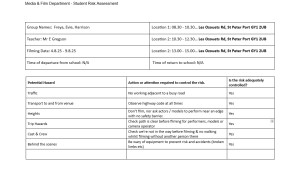We had the privilege of discussing our horror film with Premiere and editing expert Lenny Lenfestey.
We was impressed with my cinematography and Ben’s editing, particularly the composition of my shots and the match cuts and camera shakes that Ben had incorporated in post. He suggested we outline our shadows more to hone in on the German Expressionist element, and also gave us a few tips on workspace management and chromatic abberation.
By adding an adjustment layer over our film, we could induce chromatic aberration which would provide a halo of colours around the characters/objects. This could be adjusted with an oval lens and feathering, on top of adding a light vignette around the whole frame, to express an otherworldly feel and add depth to the framing.
A workspace tip he suggested was to use bins whilst editing in Premiere and to organise them into sequences, adjustment layers, footage, audio, and more. Particularly when you may have several edits, it can be overwhelming to have several files named ‘final’ and ‘final final’ or so on: Lenny mentioned we name them WIP (work in progress) 01, 02, 03…and whenever a major change had been made or the copy was ready, call them V01 (versions), 02, 03… This way we can draw back to our historical copies without losing any progress made, just copying and pasting bits we may need or want to change. He also taught us how to use key combinations to see our full timeline and enlarge a screen/area, for example.
He also told us to reflect on the look we may want for our film, especially if we were going for a more black-and-white, grainy, German Expressionist mood. However, he was impressed with the quality of our edit and the diversity of gloom-expressing angles we had used.
Lenny spoke to Jess about sound design and whilst he may not be an expert in Audition, he stated that most of the important effects used in After Effects and Audition could be found in Premiere anyway. He liked the way she had layered the screams for the possession scene and told her to look at other software such as Voice Enhancer and adding studio reverb to clarify the screams and add/reduce echo.
This was overall a very interesting and inspiring experience, and I am very grateful to be able to receive and understand Lenny’s insights. Whilst we may not be able to use all this in our horror films, they are great tips and I look forward to putting them in my own projects.













